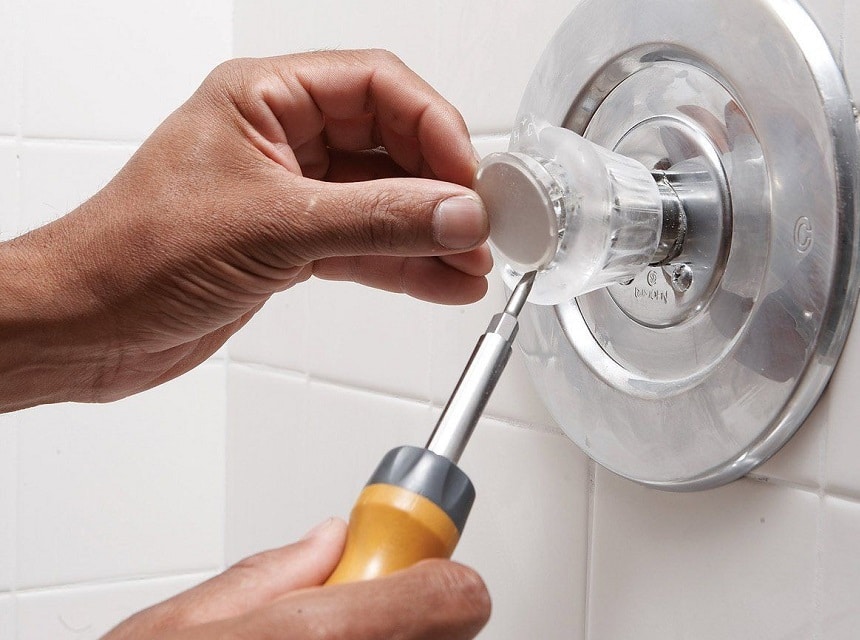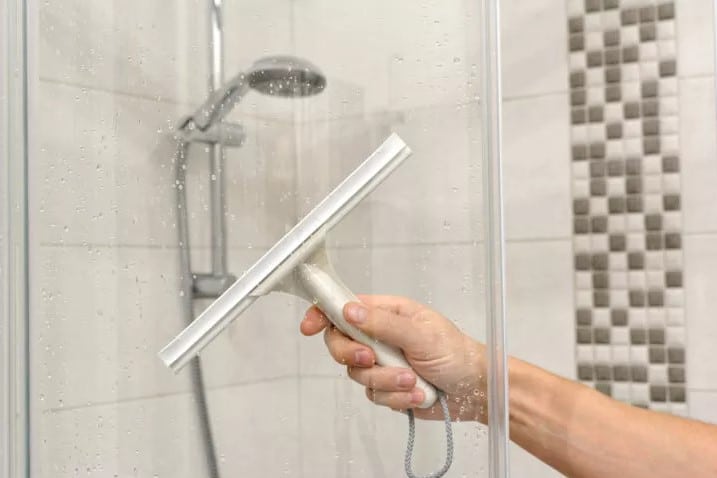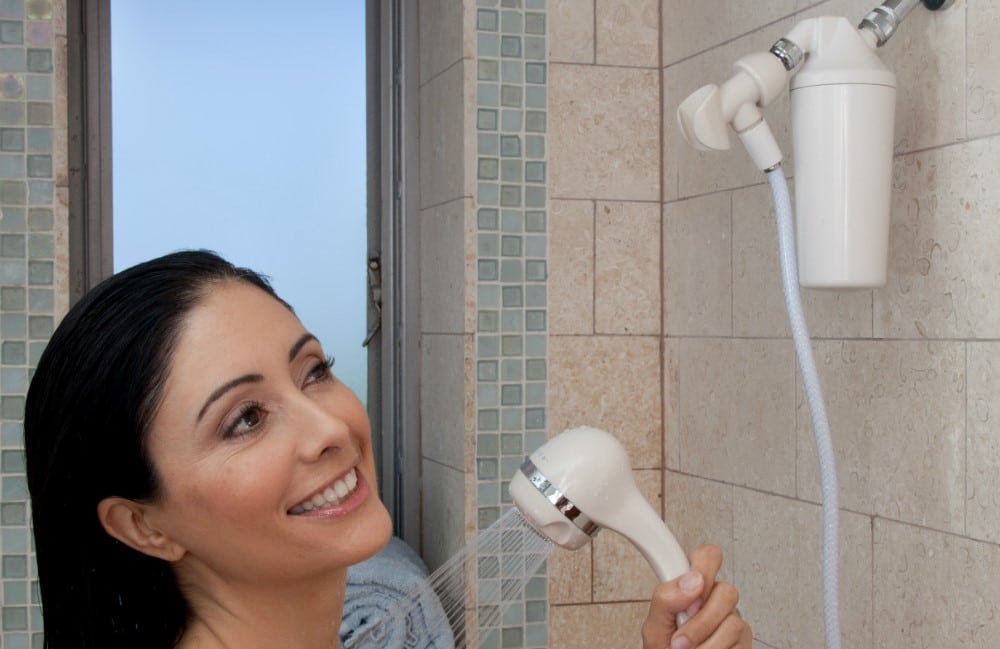Few things are as soothing as a lengthy, hot shower after an exhausting day. Perhaps it’s something about water flowing at a high pressure to wash the day off. Until suddenly you find yourself standing under a mere trickle of water where a jet stream of water once was. Suddenly the pleasure of a hot shower becomes very frustrating!
Have you ever found yourself wondering how to increase shower water pressure? Fortunately, there are several inexpensive options to consider if you’re struggling with the current water pressure in your shower. Today we’ll be looking at a few of them as well as potential situations that could be causing the problem.
Read on to see what you can do to increase water pressure in your shower if you’re living in an apartment building. I’ll also tell you about a few products I’ve found most useful in getting the water pressure back to where it should be! Solving the low water pressure problem in your shower can be quick and easy to fix if you know where to look.
In general, American households use an average of 300 gallons of water every day. About 70% of this usage occurs indoors for activities that include showering, bathing, dishwashers, washing machines, cleaning and toilet flushing.
In American homes, the standard for water pressure is an average of 40 to 45 pounds per square inch (or PSI). If you have previously had an acceptable water pressure and find that it’s suddenly dropped, there is probably a simple explanation for it.
Since water pressure problems aren’t usually issues you deal with regularly, you might not always know where to look. Let’s have a look at a few of the most common reasons why you could be experiencing low water pressure.
If your water pressure changes from one day to the next without any obvious reason, it could be an issue with your water supplier. They could be working on water lines in the area. Before you start tinkering around with pipes, valves or water mains contact the water supplier and establish if they’re aware of issues in the area. You should ask your neighbors if they’re experiencing similar problems.
If you’re the only one on the street experiencing low water pressure, it means the problem is specific to your property. The first place to check could be the main shutoff valve. If you’ve recently had any plumbing or other building work done, it could be possible that a contractor closed the valve and didn’t re-open it.
Pressure regulators aren’t mandatory on all plumbing systems. So, this could only be a potential problem if your system actually has a pressure regulator. The best way to check this would be to attach a water pressure gauge to the hose spigot. Turning the water on will give you an immediate reading of your water pressure.
Pipes can easily become clogged anywhere along the pipeline. Items that could cause clogging include sediment or limescale build-up. While you can flush out some of the pipes, it might be necessary to call a plumber for blockages further along the water lines.
Plumbing pipes and water lines are not items you tend to do anything with unless there’s a problem. This means that pipes aren’t changed at regular intervals. So pipes can easily become corroded, especially in older homes.
Often the building renovations you do to an existing house could add to the corrosion of pipes and lines. Most times when homes are extended, the main branch lines aren’t extended. This results in extra pressure on the pipes which means they will corrode faster.
Another cause of pipe corrosion is the continued use of drain cleaners and other harsh chemicals. Always check if the chemicals you’re using are compatible with the pipe systems you have in place.
Another common problem is leaking pipes. It can take a small leak to severely affect your water pressure. A water leak misdirects your water supply and this will in turn affect the pressure that comes out of your taps.
If the situation you’re currently facing involves searching for ways to improve the water pressure in your shower, you’ve come to the right place. Here are 12 of our tips to increase the water pressure in your shower.
It’s as simple as working through our list to determine the most likely cause of your water pressure problem. Before you opt for the more expensive options, it’s crucial to do the basic checks. You might end up solving the problem with little or no cost to yourself.
Leaking pipes can easily minimize the amount of water that flows out of your shower. While you can temporarily fix leaking pipes with epoxy putty or a host of other plumbing quick fixes, it’s important to call a plumber as soon as possible.
Leaking pipes can cause serious water damage to other areas of your home or property. In addition to that, water that’s continuously leaking from your pipes will cause an inflation in your water bill. So, the sooner you get it fixed, the less inconvenience it’ll cause
If you have recently relocated to a new home or had any plumbing work done, it’s important to check the main shut-off valve. Plumbers or other building contractors often turn the water mains off to complete their work and forget to turn it back on.
The water mains are usually situated where the main system enters your property. Make sure it’s fully open. Check to see if opening this valve has made any difference to the water pressure. If it hasn’t, it simply means the problem is not at the water valve. Leave the valve open so that the rest of your home can get the right water pressure.
Over time and with continued use, showerheads can easily become blocked with mineral deposits and limescale. When this happens, the water flow slows down and often only trickles out.
To rectify this, simply unscrew the showerhead and clean the build-up on the inside. Using a small brush (like a toothbrush) should remove any build-up. An easy way to clean the gunk from the inside of your showerhead would be to soak it in a vinegar solution overnight or for a few hours during the day.
One of the simplest quick fixes would be to check the water line or hose for kinks. Some showers have flexible lines as opposed to solid pipes and these lines can get kinks. Handheld showerheads can become twisted and cause the water flow to slow down.
The introduction of the National Energy Act has in recent years led to the incorporation of flow restrictors in showerhead designs. Flow restrictors serve to reduce consumers’ water bills as well as protect the environment. But that doesn’t really solve the water pressure issue in your shower, does it?
If you suspect this to be the problem, simply open the showerhead and remove the flow restrictor. The showerhead’s user manual will give you a step-by-step guide on how to do this. Once you’ve removed the flow restrictor, test the shower and check the water flow is better.
Bear in mind that keeping the flow restrictor out might increase your water bill, so you might only want to do this as a temporary solution.
When you have checked all the plumbing, pipes, lines and tanks but you’re still experiencing a water pressure problem, it might be time to move to the next step. Buying a new showerhead specifically intended for low water pressure could be a simple and inexpensive way to solve the problem.
While a new showerhead itself can’t solve the problem of low water pressure, these products can increase the jet of water that sprays from the showerhead. If the showerhead is the problem, you might consider purchasing a Speakman S-2252-BN Signature Brass Icon Anystream High Pressure Adjustable Showerhead.
This nifty solid brass showerhead features the advanced Anystream Technology which gives you three advanced settings ranging from “intense, rain and full flood.” Showerhead plungers easily control the way the water is spread and leaves the muzzle free to intensify the stream. This makes it one of the best showerheads for low water pressure. A quick and simple way to speed up your low water pressure problem!
An added benefit here with this particular low water showerhead is its self-leaning plungers which are ideal to use in areas with hard water. The plungers prevent sediment and mineral build-up making the head itself very easy to keep clean.
An easy way to determine if the cause of your low-pressure nightmare could be water heater-related is to test the water pressure when using cold water. If the low water pressure problem seems to be specific to using the hot water, then the problem is most likely originating from your water heater.
Check if the shut off valve is open. If it’s closed, opening it could potentially solve the problem. It’s possible that the water tank has become blocked by limescale or sediment. Drain the water heater and flush out all the pipes, lines as well as the tank.
One of the most obvious but sometimes less thought of problems can be solved simply by checking which other appliances are on at the same time. Appliances like dishwashers and washing machines that work simultaneously as the shower could place an increased demand on your home’s water supply, one your infrastructure can’t cope with.
In areas where water pressure has always been strong, this shouldn’t matter much. But, if the water pressure in your area is already strained, using all these appliances together will cause the water pressure in the shower to be lower.
A simple way to fix this would be to reduce the strain on your home’s water supply. Perhaps use the shower first and afterward switch the dishwasher or washing machine on. If this solves the problem, you simply have to change the times you do the washing and the dishes to after everyone has showered!
One of the more expensive options to consider when all else has failed is to install a hot water pump. These shower pumps boost the existing water flow to create more pressure. This is usually the best option for areas where the water pressure is generally low. Essentially, you’ll be making the best of the situation you’re facing.
Unfortunately, these options can be very expensive and will most likely require a plumber to install. One of the better water pumps to consider is the Watts Premier Instant Hot Water Recirculating Pump System with built-in timer.
This water pump kit prides itself on being able to provide hot water at exactly the pressure and temperature you require. The patented valve has a sensor that opens when the water reaches the required temperature. This eliminates water wastage. Easily one of the best hot water recirculating pumps currently on the market, this unit mounts directly onto the hot water line, making installation quick and easy!
The water main on your property is the underground pipe that the water supplier uses to deliver water to each house in the residential area. The problem could be a result of malfunctions with your area’s water supply. If the water main is broken or faulty, all the homes in the surrounding area will struggle with low water pressure.
Installing a well system will improve your water pressure because the water isn’t supplied by a water supplier. Well water comes from the aquifer underground and as a result tends to be fresher and cleaner. There will be no sediment build-up in the pipes as is often the case with recycled water supplied by water suppliers. The residue is often because of the chemicals used for purifying the water.
To have a well system installed, a plumber will simply extend a pipe into the underground aquifer. The pipe then draws water out of the aquifer and up into the existing plumbing system. If you’re going to invest in this type of system, it might be a good idea to let your plumber upgrade some of the older pipes, valves and fittings in the rest of your plumbing system.
The biggest advantage of installing a water filter is the benefits it has on your pipes. Materials like limescale, iron and manganese lead to build-up in the pipes which can cause pipes to be blocked or corroded. An iron build-up in the water pipes negatively affects the lifespan of your appliances.
Minerals such as calcium and magnesium easily bond with water molecules causing build-up. This happens when you’re in an area that has hard water Trusted Source Hard water - Wikipedia Hard water is water that has high mineral content. Hard water is formed when water percolates through deposits of limestone, chalk or gypsum which are largely made up of calcium and magnesium carbonates, bicarbonates and sulfates. en.wikipedia.org . Water filters prevent these chemicals from getting into your pipes in the first place.
One of the most popular filtration systems currently available is the iSpring WGB32B 3-Stage Whole House Water Filtration System. This quality water sediment filter can effectively achieve filtration down to a staggering 5 microns. The iSpring removes approximately 99% of chlorine usually found in supplied water.
95% of rust, sediment and industrial solvents are also removed with this whole house water filter. Since it gets installed directly onto the main water supply, it easily treats all the water in your home. With a capacity of 100,000 gallons of water, it’ll easily supply a small family with all the clean water they need for a whole year!
Living in an apartment building limits the actions you can take to rectify any water pressure problems. Apartment buildings built before the 1960s often have plumbing systems made of galvanized steel pipes.
It’s very easy for pipes this old to become corroded over such a long period of time. This corrosion is often the cause of water pressure issues in apartment buildings. Let’s look at a few ways you can increase the water pressure in your apartment.
One of the most common reasons you might experience low water pressure in your apartment could just be timing. If any of the tenants are using the water at the same time, it places a lot of demand on the water supply.
This will take some trial and error to work around. What you’ll need to do is test the water pressure at different times of the day to determine the building’s peak hours. If you see that water pressure could be exceptionally lower in the early evening it could just be a problem of supply-demand.
Most people will be using water with dishwashers and showering when they get home from work. Earlier mornings could show a similar pattern as people will be using showers and baths before work. Schedule your showers and dishwasher usage around these peak hours.
One of the easiest remedies would be to change your showerhead to a low-pressure showerhead. We’ve mentioned a top-quality product ideal for this already. This type of showerhead will easily adjust a low water pressure to a more suitable pressure.
Just as homeowners with their own properties would do, you can also check the pipes in your apartment for clogs and leaks. If you find any of these, you might want to bring this to the attention of the building maintenance team so that the problem can be efficiently dealt with.
Sometimes the problem in your shower is only specific to the hot water. The cold water pressure is just fine but things start slowing down when you need to use the hot water. This could be a clear indication of a problem with the hot water system.
Fortunately, there are a few steps to follow that will help you fix the low hot water pressure.
From our informative list it’s easy to see there isn’t only one reason that your water pressure could be low. Some of the reasons could be easy and inexpensive to fix while other solutions are a little more costly. But do something before a small problem causes more extreme issues. It’s always a good idea to start with the basics and work your way down the list from there.
If you’re dealing with older pipes and plumbing it might be wise to have a plumber perform an assessment to check for any potential problems. This will prevent you from experiencing any water pressure related issues down the road. Make sure you definitely won’t have to spend any time trying to figure out how to increase shower water pressure! Let the experts handle it for you as soon as possible!





